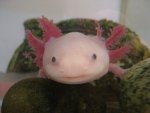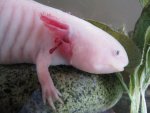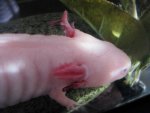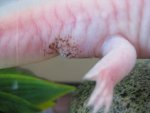Beth
New member
- Joined
- May 13, 2010
- Messages
- 10
- Reaction score
- 0
- Points
- 1
- Location
- Reading, UK
- Country
- United Kingdom
Hi everyone,
I’ve had Oxo for about 4 years and am his third owner. I think he’s about 10 years old now. He lives in a 60x30 cm tank on his own with a piece of slate covering the floor, a plastic hamster house and various plastic/fabric plants, shells and big stones to clamber on. He has a Fluval One Plus filter, mainly eats pellets, with occasional bloodworms, shrimps or small bits of beef, and has a 30% water change every week. I use dechlorinated tap water, which I also leave to stand for a few days beforehand, with a bit of start-up bacteria added.
His tank is 19 degrees centigrade right now and I keep it roughly at that temperature in the summer as well by floating bottles of frozen water in there. I just did a strip test (his last water change was 4 days ago) and have:
NO3 50 mg/l
NO2 1 mg/l
GH 16 dH
KH 20 dH
PH 8
Cl 0.8 mg/l
Oxo’s gills have always looked a bit iffy (see picture 1), which I put down to his previous owner using untreated tap water, but a couple of years ago he started to grow what look like extra veins from them as well and has lost some of the filaments (see pictures 2 and 3). He also has some black stuff (sorry to be vague) on his cloaca (see picture 4), which has recently also appeared in two spots on his back and on his lower lip. The spread of the black stuff varies, but his skin is much rougher there, so I think it is affecting his slime layer.
Is this a bacterial infection? (He poos only about once a fortnight, so I wonder if it is a side effect of constipation?) Is what has happened to his gills common in older axolotls (a work colleague mentioned the same happened to his pet sometime before it died) or are they getting burned* and trying to repair themselves? (*Could it be an ammonia or nitrite build-up, even though he eats all of his food, I clean away his poos straight away and there are no live plants in the tank?)
Does anyone have any suggestions about what I could try to help him, please? Neither issue seems to have affected his behaviour or appetite, which is why I have not posted for help sooner, but I am concerned that I am doing something wrong or missing something that is hurting him.
Thanks for your help!
Beth
PS – The more I read on this forum, the more I think ammonia is probably to blame for his gills as I don’t have a test for it. Does anyone have a recommendation for a test brand and a way to reduce it, please?
I’ve had Oxo for about 4 years and am his third owner. I think he’s about 10 years old now. He lives in a 60x30 cm tank on his own with a piece of slate covering the floor, a plastic hamster house and various plastic/fabric plants, shells and big stones to clamber on. He has a Fluval One Plus filter, mainly eats pellets, with occasional bloodworms, shrimps or small bits of beef, and has a 30% water change every week. I use dechlorinated tap water, which I also leave to stand for a few days beforehand, with a bit of start-up bacteria added.
His tank is 19 degrees centigrade right now and I keep it roughly at that temperature in the summer as well by floating bottles of frozen water in there. I just did a strip test (his last water change was 4 days ago) and have:
NO3 50 mg/l
NO2 1 mg/l
GH 16 dH
KH 20 dH
PH 8
Cl 0.8 mg/l
Oxo’s gills have always looked a bit iffy (see picture 1), which I put down to his previous owner using untreated tap water, but a couple of years ago he started to grow what look like extra veins from them as well and has lost some of the filaments (see pictures 2 and 3). He also has some black stuff (sorry to be vague) on his cloaca (see picture 4), which has recently also appeared in two spots on his back and on his lower lip. The spread of the black stuff varies, but his skin is much rougher there, so I think it is affecting his slime layer.
Is this a bacterial infection? (He poos only about once a fortnight, so I wonder if it is a side effect of constipation?) Is what has happened to his gills common in older axolotls (a work colleague mentioned the same happened to his pet sometime before it died) or are they getting burned* and trying to repair themselves? (*Could it be an ammonia or nitrite build-up, even though he eats all of his food, I clean away his poos straight away and there are no live plants in the tank?)
Does anyone have any suggestions about what I could try to help him, please? Neither issue seems to have affected his behaviour or appetite, which is why I have not posted for help sooner, but I am concerned that I am doing something wrong or missing something that is hurting him.
Thanks for your help!
Beth
PS – The more I read on this forum, the more I think ammonia is probably to blame for his gills as I don’t have a test for it. Does anyone have a recommendation for a test brand and a way to reduce it, please?




